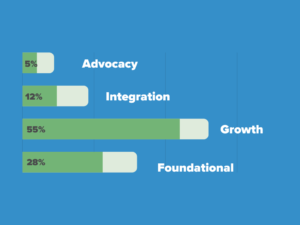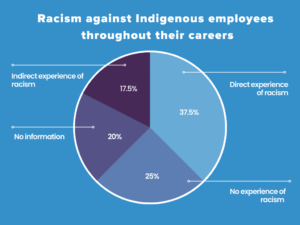The first-ever comprehensive Indigenous Employment Index is showing how under-represented Indigenous Australians are in the workforce.
While workplace diversity and inclusion (D&I) has grown in prominence in recent decades, there’s still a long way to go in transforming Indigenous representation and inclusion in the Australian workforce.
The Woort Koorliny: Australian Indigenous Employment Index 2022, developed by Minderoo’s Generation One Initiative, in partnership with Murawin and Bankwest Curtin Economics Centre, demonstrates exactly how much work needs to be done.
“We’re trying to close the Indigenous employment gap in Australia,” says Shelley Cable, Director, Minderoo Foundation’s Generation One initiative.
Cable is a Wilman-Nyoongar woman from Perth, who, along with her team members, is on a mission to close the Indigenous employment gap in Australia.
Cable sat down with HRM to discuss the key findings of the Index and to shed light on what HR practitioners and leaders should concentrate on to drive meaningful change in their workplace cultures and to boost Indigenous employment outcomes.
Why we need change
From 2008-2018, not much progress was made in relation to increasing the percentage of working-age Indigenous Australians in employment. As the Index demonstrates, the gap has only closed by 1.3 per cent over this decade, which showed that organisations were still lacking the expertise to bolster Indigenous employment initiatives.
Nearly five years on and progress is still slow.
Minderoo’s Indigenous Employment Index surveyed 42 Australian employers to understand how advanced organisations were when it came to facilitating a culturally safe environment for Indigenous employees.
This is the first-ever extensive coverage that focused on the careers and aspirations of First Nations Australians, and is designed to help organisations interpret the reality of employment, retention and workplace experiences of Indigenous people.
“We’ve tried to capture the voices of Indigenous Australians throughout the report. We have countless quotes and stories that were shared by Indigenous employees for our research.
“When you’re trying to tackle a complex challenge, such as closing the Indigenous employment gap, without any data on the problem you’re trying to solve…you’re not quite sure where to start. It can be difficult to make good decisions.”

The image above represents four different categories employers fit in, in terms of their maturity level when it comes to Indigenous inclusion:
- Advocacy represents the highest stage, meaning employers have achieved outcomes for Indigenous employment across all domains, including supporting other employers on their journey to inclusion.
- Integration means employers are embedding a wide range of practices to enhance inclusion and seeing strong results.
- Growth means organisations are starting to implement Indigenous employment practices and there are visible outcomes as a result.
- Foundational level employers have made some commitments, and perhaps started committing to some initiatives, but they are yet to see any results.
Only five per cent of the respondents in the Index were actively advocating for transformation in their workplaces and had strong policies in place to support Indigenous staff.
Almost a third (28 per cent) were in the lowest performing group, which indicated they were either early on their journey or had no key practices in place.
However, it’s promising to see 55 per cent of the employers in the ‘Growth’ category, demonstrating that they’ve taken the first steps towards implementing their organisation’s inclusion policies.
Although the ‘Growth’ category shows strong intent and goodwill in making workplaces more culturally safe, these employers often “don’t know how to practically facilitate an inclusive and diverse workplace to achieve that,” says Cable.
Three reasons for employment disparity
While some organisations have begun looking into the Index and seeing potential fixes in their organisations, the employment disparity cannot be solved by looking at a single measure.
Instead, Cable says there are a range of barriers and learning opportunities that employers should embrace. For example:
Lack of employer and Indigenous Australian relationships
When looking for new hires, recruiters often search for prospects without expanding their scope for candidates from diverse groups, says Cable.
“The relationships that employers have, or don’t have, with the Traditional Owners, how and where they operate in the country, and what the business’s reputation is like can certainly influence the Indigenous employment results at that organisation,” she says.
According to the stats collected by Minderoo’s researchers, Indigenous-owned businesses are 100 times more likely to employ Indigenous workers than other businesses.
This could be reflective of the fact that non-Indigenous employers are less informed about ways to create a sense of belonging for Indigenous employees, she suggests.
“We’re trying to close the Indigenous employment gap in Australia. To do that we need to put another 300,000 Indigenous Australians in employment by 2040.” – Shelley Cable, Director, Minderoo Foundation’s Generation One initiative.
In order to combat this, Cable highly recommends employers read the Workplace Culture and Inclusion (pp. 58-91) and Indigenous Perspectives (pp. 32-35) sections of the national report to better understand Indigenous concepts, experiences and practices.
Employers need to ensure their leaders, including line managers, have cultural awareness and capability, develop trust with Indigenous employees and have the knowledge about the organisation’s commitment to Indigenous employment.
Read HRM’s article on six common questions you can ask to better support Indigenous employees
This will ensure that safe and respectful conversations can occur between the leader and the employee about their needs.
Many workplaces aren’t suitable for Indigenous people
Another key challenge cited by the Index was the fact that many workplaces lack cultural awareness and capabilities to create enticing workplaces for Indigenous talent.
“Often people don’t understand what reality is like for Indigenous employees. I think [studying the Index in detail] is a great way to build someone’s understanding of how Indigenous employment looks to some Indigenous Australians, and how their policies and practices as an organisation can be interpreted and affect Indigenous employees.”
Lack of knowledge about creating inclusive workplaces
According to Cable, one of the most critical factors in helping Indigenous talent to thrive is making sure inclusion is woven in at a cultural level.
She also adds that most DEI strategies are broad in nature, and so it’s important to carry out Indigenous-specific focus to uplift your Indigenous employees and show that you truly value them.
“If you have a manager who leads Indigenous employees, they should undertake specific training around what it’s like to lead Indigenous Australians and be given extra training and education, whereas other employees in the organisation might not need that level of detailed training.”
Combatting retention challenges
Another key finding in the Index was challenges around retaining Indigenous employees.
The research revealed only half of the 42 employers surveyed collected data on Indigenous retention rates. For those that did, the majority (nearly 62 per cent) reported low retention of Indigenous employees.
Additionally, over a third of the participating employers did not invest in Indigenous-specific learning and development opportunities to advance the development of their Indigenous staff.
The index also revealed that only 0.7 per cent of executive and senior management roles were occupied by Indigenous Australians.
“It’s about employers asking themselves, ‘Why aren’t Indigenous Australians at their leadership tables?’
“We are asking employers to focus on the entire lifecycle of their employees and show that they’re not simply a number,” says Cable. “Their contributions are valued and they deserve to be in senior leadership positions as much as anybody else.
“We’re [also] asking employers to make sure they focus on Indigenous retention and engagement of their current staff, as much as they focus on the recruitment of Indigenous staff.”
It’s also important to call out that no workplace should be assumed as being culturally safe for all its employees, says Cable.
The Index revealed that racism against Indigenous employees is still a prominent issue, with over 50 per cent of Indigenous interviewees experiencing direct or indirect racism throughout their careers.

It’s crucial to treat racism as a safety issue in the workplace, as it’s often still not widely understood or addressed in the right way.
Moving the needle on inclusion
Here are five ways Cable believes HR practitioners can create more inclusive and engaging environments for Indigenous employees:
- Strike up a conversation with Indigenous candidates to understand their lived experiences and the reality of working at your organisation.
- Run ‘exit interviews’ with departing Indigenous employees to gauge their authentic experiences. (See HRM’s article on questions to ask in an exit interview).
- Commit to a comprehensive strategy, set robust targets and report on them publicly on a regular basis. It’s also important to follow this up with clear action points.
- Ensure there’s a strong oversight of your current policies and practices, and consider how this is relevant to Indigenous employees (or potentially excluding/discriminating against them).
- Finally, reflect on how to engage and tap into the potential of First Nation employees in your organisation.
Making progress on Indigenous inclusion at work isn’t a journey Cable wants employers to take by themselves.
“I want to take the pressure off organisations who think they’re supposed to have all the answers. They can reach out for help,” she says. “There are so many Indigenous employment services, recruitment organisations and employment agencies that can guide you in the right direction.”
Australia’s First Nations population only accounts for three per cent of the population, so they cannot spearhead this conversation without the support of the 97 per cent of Australians, says Cable.
“You can’t rely on one particular cohort to drive this. It has to be leadership; it has to be management; it has to be HR practitioners and Indigenous and non-Indigenous Australians coming together.”
In order to guide employers on how to drive a positive and an all-inclusive work culture, the Index offers a freely accessible ‘Employment Roadmap’ as a practical guide to help to gradually establish effective Indigenous employment practices. You can access the interactive employer roadmap here.


I’m all for a society that is treats people equally but isn’t this race based policy? When is HR going to realise that focussing on one racial identity is promoting the exclusion of others? Australia is made up of people from hundreds of different cultural backgrounds – what about them? This isn’t diversity and inclusion. HR does it with gender and sexual identity as well. It’s not inclusive practices unless you hire and promote based on job skill requirements and merit, not personal identity.